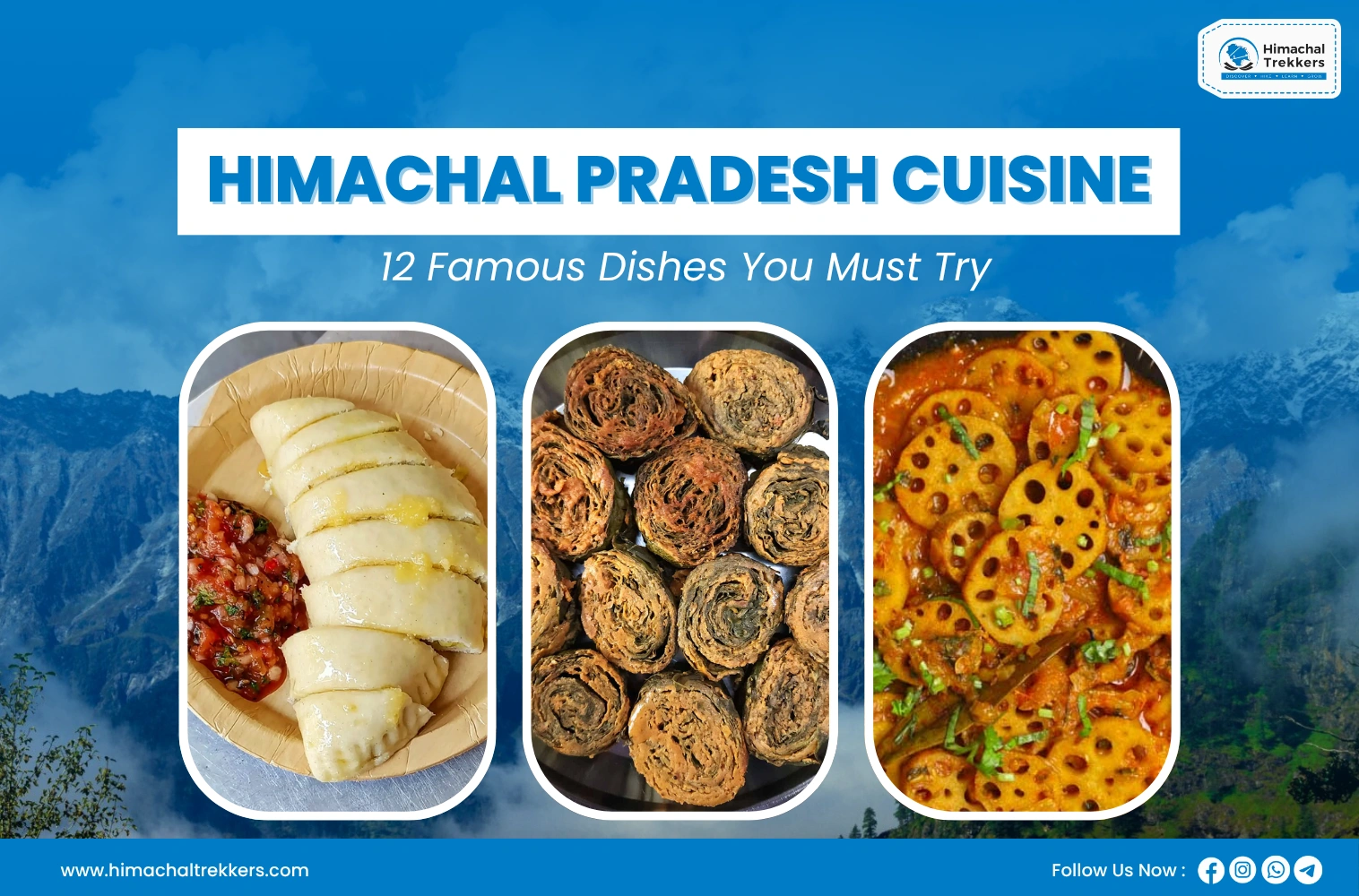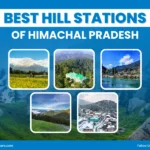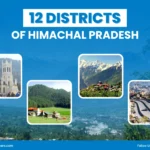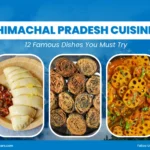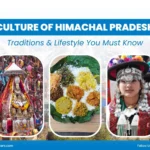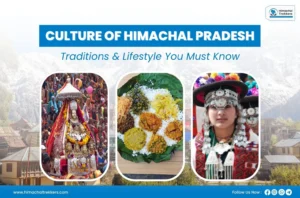The food of Himachal is famous everywhere, but there’s often confusion. Most people call it “local food,” but actually, there are two parts to it — the traditional food that has been passed down for generations, and the evolving Himachal Pradesh cuisine that blends those traditions with new flavors and styles.
Traditional food is the historic and ceremonial core — dishes passed down for centuries, often tied to rituals, festivals, or community feasts. Think of it as the roots that anchor the himachali culture.
Himachali cuisine, on the other hand, is always growing and changing. It builds on old traditions but also brings in new flavors, ingredients, and ways of serving. This is why today’s Himachali cuisine feels richer and more diverse — a living identity shaped by both heritage and modern adaptation.
This article will focus on the cuisine of Himachal Pradesh and in this article, we’ll look at 12 famous Himachali cuisine items that you need to try.
12 Famous Himachal Pradesh Cuisine Dishes
Over the years, travelers and locals alike have explored dozens of authentic Himachal Pradesh famous cuisine, but these 12 remain the most loved and recognized:
- Siddu
- Tudkiya Bhat
- Beduan Roti
- Bhey (Spicy Lotus Stems)
- Chha Gosht
- Aktori
- Kullu Trout
- Momos
- Thukpa
- Butter Tea
- Patrodu
- Chamba Rajmah
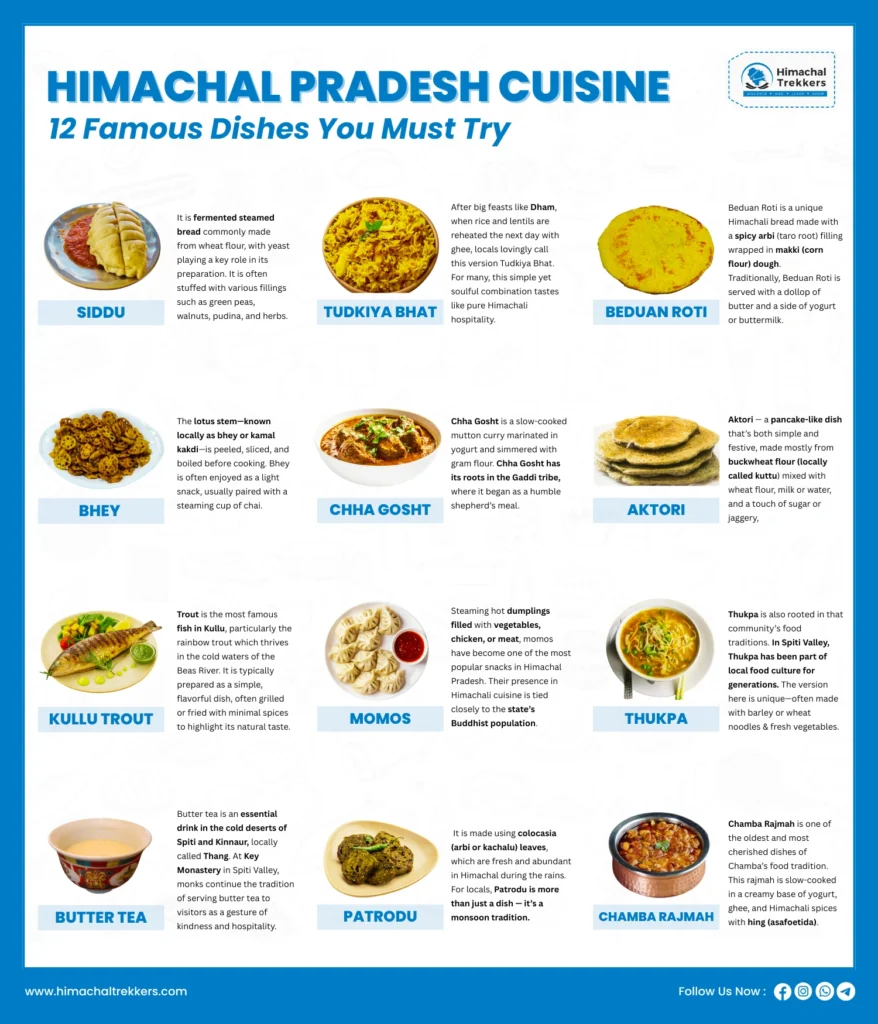
1. Siddu
If you ask people from the upper Himachal regions about their go-to snack, most will say “Siddu.” This steamed bread is one of the most loved dishes of the mountains. Originating from the old Mahasu (Shimla) area, Siddu slowly spread to other parts of the state and became a staple in homes and local eateries.
It holds cultural and seasonal importance, especially in the colder months. The name is believed to come from local dialects, with some links to the Tibetan word Tse-doe (meaning “steamed bread”), showing the shared history between Himachal and Tibetan regions. Traditionally, Siddu is served hot with desi ghee and chutneys, making it a wholesome and comforting meal.
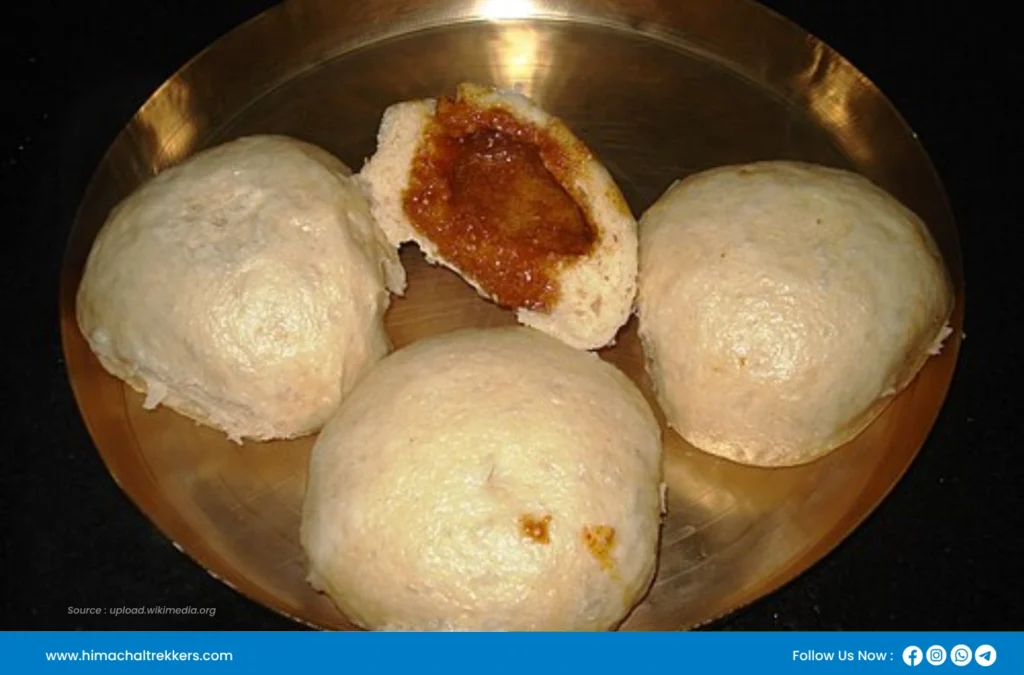
Though it has always been popular in Kullu, Manali, Shimla, Mandi, and Rohru, recently in the past 2–3 years Siddu has also become a favorite in the lower Himachal regions.
2. Tudkiya Bhat
Tudkiya Bhat is a savory, one-pot meal made with rice, lentils, potatoes, yogurt, and a special mix of spices like mace, cardamom, and dagad phool (stone flower). The result is a hearty dish that’s warming, filling, and deeply satisfying. What makes it stand out is the way flavors of vegetables, lentils, and yogurt come together, giving it a richness that regular pulao or khichdi cannot match.
Traditionally, it is served hot, topped with fresh coriander leaves and often paired with mashed dal (especially Kangra’s Teliya Mah) and a squeeze of lemon or lime for an extra kick. For many, this simple yet soulful combination tastes like pure Himachali hospitality.
There’s also a local twist worth knowing. After big feasts like Dham, when rice and lentils are reheated the next day with ghee, locals lovingly call this version Tudkiya Bhat too. It’s that kind of dish — rooted in tradition, yet flexible enough to carry the memories of community meals and festive gatherings.
3. Beduan Roti
Beduan Roti is a unique Himachali bread also famous in some regions of Uttarakhand, made with a spicy arbi (taro root) filling wrapped in makki (corn flour) dough, giving it a distinct taste and texture different from regular parathas.
The filling is prepared by cooking and grating arbi, then mixing it with flavorful spices like red chili powder, garam masala, fennel seeds, amchur (dry mango powder), dry fenugreek leaves, onions, and sometimes fresh herbs like dill or spring onions. The result is a warm, earthy, and slightly tangy stuffing that pairs perfectly with the rustic corn flour covering.
Traditionally, Beduan Roti is served with a dollop of butter and a side of yogurt or buttermilk, making it both filling and comforting. While it remains a specialty of Kangra, its unique flavor has made it a loved part of Himachali cuisine across the state.
4. Bhey (Spicy Lotus Stems)
Bhey made from thinly sliced lotus stems, cooked with gram flour, ginger, garlic, onions, and a mix of local spices. The result is a spicy, savory flavor with a tender yet slightly crunchy texture that makes it stand out from regular vegetable dishes.
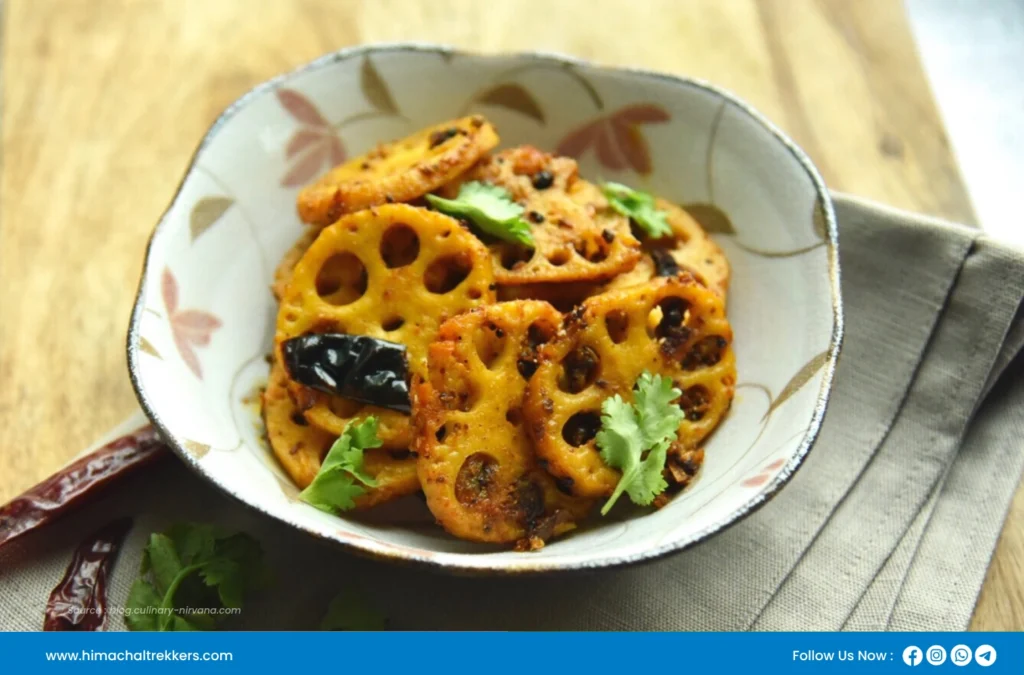
The lotus stem—known locally as bhey or kamal kakdi—is peeled, sliced, and boiled before cooking. Its subtle flavor absorbs the spices beautifully, while its crunch adds a satisfying bite. Beyond taste, bhey is also packed with nutrients: low in fat, rich in fiber, and a good source of vitamin C and potassium.
Bhey is often enjoyed as a light snack, usually paired with a steaming cup of chai. More than just food, this dish reflects how Himachali cuisine is closely tied to nature and seasonality—making use of what grows fresh and local in the region.
5. Chha Gosht
Chha Gosht is a slow-cooked mutton curry marinated in yogurt and simmered with gram flour, bay leaf, cardamom, and other local spices until the meat turns tender and flavorful. The result is a rich, tangy, and mildly spicy curry that feels both rustic and celebratory.
Chha Gosht has its roots in the Gaddi tribe, where it began as a humble shepherd’s meal. Over time, it evolved into a popular delicacy often cooked for special occasions across Kangra and surrounding regions. Traditionally enjoyed with rice or roti, the dish represents Himachal’s love for slow cooking and layered flavors.
A close cousin of this dish is Khatta Meat, a Dogra specialty from nearby Jammu that has also made its way into Kangra kitchens. Unlike Chha Gosht, it uses dry mango powder and pomegranate seeds to give the mutton curry a sharp, tangy twist.
6. Aktori
Aktori — a pancake-like dish that’s both simple and festive, made mostly from buckwheat flour (locally called kuttu) mixed with wheat flour, milk or water, and a touch of sugar or jaggery, it reflects the wholesome and straightforward food culture of the mountains.
Cooked in ghee until golden, Aktori is slightly sweet and filling, making it perfect for celebrations in the cold desert region. Traditionally, it is prepared during religious occasions and community gatherings in Spiti, where people come together to enjoy this comforting treat.
If you travel to the Lahaul and Spiti Valley during a festival, you’re likely to be served Aktori.
7. Kullu Trout
The story of trout in Himachal goes back to the early 1900s, when the British introduced brown trout and rainbow trout into rivers like the Beas and Sutlej for game fishing. Since then, these cold-water fish, thriving at temperatures between 5°C and 15°C, have become an important part of Himachali cuisine.
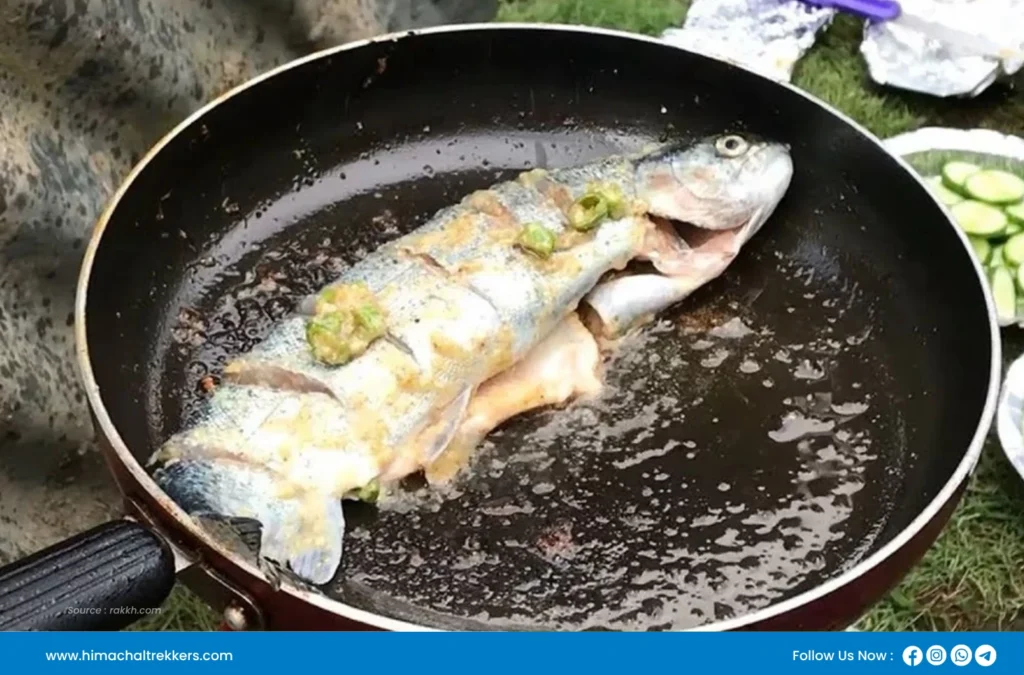
What makes Kullu Trout special is not just the taste but also the health benefits. It’s packed with protein, omega-3 fatty acids, and vitamins A, B, C, and D — while being low in fat and sodium. Plus, it has fewer spines compared to other fish, which makes eating it much easier and more enjoyable.
Barot Valley is also famous for its trout breeding farm managed by the Himachal Pradesh Fisheries Department. The Uhl River flowing through Barot makes the experience even more scenic.
8. Momos
If you go through the streets of Shimla, Manali, Dharamshala, or McLeod Ganj, one dish you’ll spot everywhere is the Momo. Steaming hot dumplings filled with vegetables, chicken, or meat, momos have become one of the most popular snacks in Himachal Pradesh.
Their presence in Himachali cuisine is tied closely to the state’s Buddhist population. Regions like Dharamshala and McLeod Ganj, home to His Holiness the Dalai Lama and a large Tibetan community, brought this dish into the everyday food scene. What was once considered a special-occasion food in Tibetan culture—reserved for weddings and festivals—slowly turned into a street-side favorite after Tibetan refugees settled here in the 1960s.
Today, Himachal is often called a “momo hotspot,” with countless variations: classic steamed momos, crispy fried ones, and even spicy tandoori versions. While you can find them almost everywhere now, locals will tell you the best momos are served in the lanes of McLeod Ganj, where Tibetan flavors feel the most authentic.
9. Thukpa
If there’s one dish that rivals momos as a comfort food in Himachal Pradesh, it’s Thukpa. Just as momos came into Himachali cuisine through the state’s Buddhist population, Thukpa is also rooted in that community’s food traditions.
In Spiti Valley, Thukpa has been part of local food culture for generations. The version here is unique—often made with barley or wheat noodles and fresh mountain vegetables like spinach, cabbage, and carrots. During the harsh winters, locals even add yak meat or mutton to make it richer and more filling.
What makes Thukpa special is not just its taste but its purpose. A steaming bowl of mildly spiced broth does more than satisfy hunger—it warms the body and helps fight the biting chill of high-altitude life.
10. Butter Tea
Butter tea is an essential drink in the cold deserts of Spiti and Kinnaur, locally called Thang. Unlike the regular sweet chai most people know, this tea is salty, creamy, and deeply warming — a perfect match for the Himalayan climate.
Its origins trace back to Tibet and Ladakh, but over time, it became a part of Himachali cuisine in the upper regions due to cultural influence. The tea is brewed strongly, then churned with butter and salt, creating a rich and savory drink that provides both warmth and energy in harsh winters.
At Key Monastery in Spiti Valley, monks continue the tradition of serving butter tea to visitors as a gesture of kindness and hospitality. Tasting it there, surrounded by mountains and prayer flags, is truly a one-of-a-kind experience.
11. Patrodu
Patrodu, also known as Patrode, Patra, or Patrodo, is a classic Himachali dish especially loved during the monsoon season. It is made using colocasia (arbi or kachalu) leaves, which are fresh and abundant in Himachal during the rains. The leaves are smeared with a spicy gram flour (besan) paste, rolled tightly, steamed, and sometimes shallow-fried for extra flavor.
This seasonal delicacy is both earthy and spicy, making it a perfect comfort food for the cool, rainy weather. For locals, Patrodu is more than just a dish — it’s a monsoon tradition. Travelers visiting Himachal during monsoon this time are often encouraged to try it, as skipping Patrodu means missing a key part of the Himachali culinary experience.
12. Chamba Rajmah
Chamba Rajmah, also known as Rajmah Madra, is one of the oldest and most cherished dishes of Chamba’s food tradition. Unlike the onion-tomato gravies found in other parts of India, this rajmah is slow-cooked in a creamy base of yogurt, ghee, and Himachali spices with hing (asafoetida) is considered essential, giving it a rich taste that feels truly unique to the region. Chambayali peoples even say the authentic flavor of Chamba Rajmah depends on the hing tadka, since it balances the richness of yogurt and ghee.
For centuries, Chamba Rajmah has been at the heart of the Himachali Dham—the ceremonial feast that defines the state’s cultural identity. Local tradition even says that this dish was gifted to the entire state by Chamba, which is why it holds such a special place across Himachal Pradesh.
More than just a curry, Chamba Rajmah carries the royal legacy of the valley and remains a symbol of how old traditions continue to flavor Himachali cuisine today.
What Makes Himachal Pradesh Cuisine Unique?
The one thing that makes Himachali cuisine truly unique is its deep connection to the land and culture of the mountains. Every dish is rooted in locally grown grains, pulses, and dairy, cooked with minimal yet flavorful spices, and shaped by regional traditions like the grand Dham feast.
This close bond with nature, climate, and community creates food that is both hearty for survival and rich with heritage — blending Tibetan influences, Punjabi touches, and centuries-old cooking methods into a cuisine that belongs only to Himachal.
Another layer of uniqueness is regional diversity. A simple dal, for example, can taste entirely different in Kangra, Kullu, or Shimla. In the higher regions, Tibetan dishes like thukpa and momos have become everyday staples, while in the lower valleys, Punjabi-style gravies and rich curries add their own influence. This mix of mountain simplicity and cross-cultural flavors is what makes Himachali cuisine stand apart.
Final Thoughts
Himachal Pradesh cuisine is a blend of simplicity, richness, and culture. From the festive Dham to the comforting Siddu and unique Bhey, each dish tells a story of the land and its people. And once you understand the difference between cuisine and traditional food, you’ll see Himachal’s food culture in a whole new light.
Next time you visit Himachal, don’t just click mountain photos for Instagram—make sure you sit down for a full Dham thali, try Siddu fresh from the steamer, and maybe even ask a local about their family’s favorite recipe. That’s when you’ll truly taste Himachal.
Now that you’ve seen 12 of the most famous Himachali cuisine dishes, remember — this is just the beginning. Himachal’s cuisine is vast, and in every valley you’ll find flavors that may surprise you even more. But these are the iconic ones you must try at least once if you truly want to taste Himachal.
Of course, trying them all in one trip is nearly impossible. So here’s our personal suggestion:
- Vegetarian? Start with Siddu and the legendary Chamba Rajmah.
- Non-Vegetarian? Don’t miss the rich Chha Gosht or the Khatta Meat.
Whichever you choose, you won’t just be eating food — you’ll be tasting the culture, history, and spirit of the mountains.

